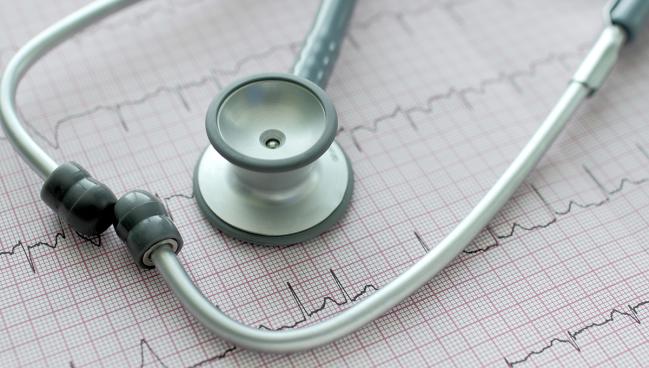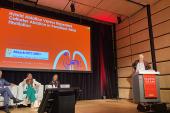CASA-AF: Similar 3-Year Efficacy for Surgical and Catheter Ablation
Quality of life was also similar, but the catheter procedure was less expensive, making it a potential first-line option for some.

Surgical and catheter ablation are both effective for the long-term reduction of persistent atrial fibrillation (AF) burden, according to 3-year data from the CASA-AF trial. The study also included a cost-effectiveness analysis that found significant savings with the less-invasive procedure.
Emphasizing the challenge of treating this difficult patient population in clinical practice, Tom Wong, MD (Royal Brompton & Harefield Hospitals, London, England), said the results achieved from a single procedure are encouraging.
“Given the equipoise between catheter and surgical ablation modalities and clinical outcomes, and that surgical ablation is more costly, perhaps we would recommend a less-invasive catheter ablation as the first-line option to treat de novo symptomatic, long-standing, persistent atrial fibrillation, at least in the UK setting,” Wong said in a late-breaking trial presentation last weekend at Heart Rhythm 2024.
The topic is a hot one in this field, with the European Heart Rhythm Association and others having recently updated their expert consensus as a result of advances in pulsed-field ablation (PFA) catheters, increasing use of intracardiac echocardiography (ICE), and the success of hybrid approaches that combine surgical and catheter ablation.
Wong’s data, which constitute the final long-term follow-up of CASA-AF, also showed similar health-related quality of life (QoL) between patients randomized to surgery or catheter ablation.
Importantly, more than 55% of patients in both arms had a 75% or greater reduction in AF/tachycardia burden that was maintained at 36 months after just a single procedure.
Christine Tanaka-Esposito, MD (Cleveland Clinic, OH), the discussant for the trial, agreed that catheter ablation appears to be the more favorable of the two options, adding that the results “reassure us that high-quality ablation can help control arrhythmia burden and improve symptoms, even in this population at the most advanced end of the clinical spectrum.”
CASA-AF at 3 Years
In the main CASA-AF trial results, surgical ablation conferred no benefit over catheter ablation in terms of freedom from AF/tachycardia, AF burden reduction, or procedure-related serious adverse events at 12 months. QoL and cost analyses favored catheter ablation. Approximately 70% of patients in both arms had ≥ 75% reduction of AF/tachycardia burden at 12 months.
The 115 patients in the trial (mean age 62 years; 27% female) had had continuous AF for 12 months or more before being randomized. Follow-up at 36 months was completed in 57 patients who underwent surgical ablation and 47 who had catheter ablation without antiarrhythmic drugs. An implantable loop recorder provided continuous arrhythmia monitoring in patients in both arms.
Only a small percentage of patients were completely free from AF/tachycardia at 36 months, but the percentage was similar in both arms (P = 0.41). The primary endpoint of a reduction in AF/tachycardia burden of ≥ 75% was achieved in 58% of the catheter ablation group and 55% of the surgical group (P = 0.91).
The overall impact on health-related QoL as estimated by quality-adjusted life-years (QALYs) was lower with surgery at 2.32 versus 2.45 with catheter ablation, but the difference was not statistically significant. Costs in the surgical arm were a mean of £24,682 versus £18,002 for catheter ablation, with the difference being driven by the cost of the procedure itself, Wong said.
In an exploratory post-hoc analysis, large left atrial diameter, lower age, and chronic, persistent AF were indicators of failing arrhythmia outcomes.
According to Wong, surgical techniques are being refined alongside advances in catheter ablation, which means “we have to keep our mind open [regarding] surgical techniques moving forward.” He added that PFA has come into its own, having gone “mainstream” in many centers, which promises to provide much more data in the future on how patients treated with this newer technology fare in the long term.
In their paper, Wong and colleagues say another takeaway from this study is the importance of the implantable loop recorder in assessing success of therapy. Much of the long-term data in the literature has relied predominantly on Holter monitoring, they note, which may be a less accurate means of detecting both the occurrence and burden of arrhythmia in these patients.
L.A. McKeown is a Senior Medical Journalist for TCTMD, the Section Editor of CV Team Forum, and Senior Medical…
Read Full BioSources
Boyalla V, Haldar S, Khan H, et al. Long term clinical outcomes and cost-effectiveness of catheter vs thoracoscopic surgical ablation in long-standing persistent atrial fibrillation using continuous cardiac monitoring: CASA-AF randomised controlled trial. Heart Rhythm. 2024;Epub ahead of print.
Disclosures
- Wong reports no relevant conflicts of interest.





Comments